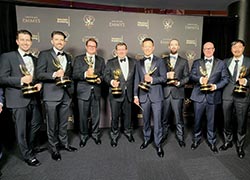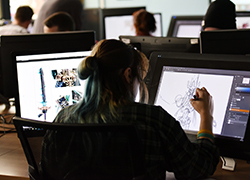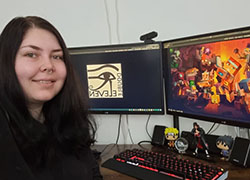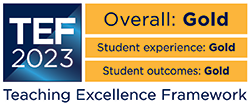Course overview
Foundation year Work placement
2D Animation and Stop Motion Showreel
View our BA (Hons) 2D Animation and Stop Motion student showreel.
You learn essential animation skills including drawing and pre-visualisation, cinematography, hand drawn 2D animation and stop motion techniques.
Gain experience of the animation pre-production and production pipelines by working with other animation students on team projects as specialist 2D animators, stop motion animators, stop motion compositors, prop makers, set builders or character designers.
Our bespoke 2D animation studios featuring industry-standard software, dedicated workshops and stop motion studios equipped with lighting, cameras, and green screen offer you a real world technical experience.
Top reasons to study 2D animation and stop motion at Teesside
- International acclaim: ranked 19th in the world in the Animation Career Review International Animation School Rankings 2024. (Top 50 International Animation Colleges – formal degree. 195 colleges considered). (tees.ac.uk/source).
- Industry links: take part in Animex, our annual international animation and games festival featuring experts from Rockstar, Pixar, Disney and Sony.
- Career-ready: our ExpoSeries of events allow you to showcase your skills to industry professionals who are seeking to recruit new and rising talent.
- Quality teaching: 92.4% of computer games and animation students agreed that staff often made the subject engaging (National Student Survey 2024, tees.ac.uk/source).
Course details
Course structure
Year 1 core modules
The principles of animation are the foundation stone for any animator. Originally created by Disney, they have been used by generations of animators to create convincing animation across movies, TV series, games and commercials.
Fundamentals of 2D animation
Learn the principles of 2D animation, using hand-drawn techniques to create animation exercises.
Fundamentals of 3D animation
Explore the principles of 3D animation using industry standard techniques and software using a range of methods including the layered method and pose to pose.
Animation in context
Delve into the history of animation and motion design, from its earliest beginnings to today’s diverse styles and applications.
This is a 30-credit module.
Unlock the secrets of character creation, storyboarding, and environment sketching in traditional and digital drawing.
Traditional drawing skills
Study life drawing and observational techniques, perspective and composition.
Digital drawing skills
Explore image manipulation techniques using digital software and customising digital drawing tools. Dive into character design, environmental creation and prop development.
This is a 30-credit module.
Embark on a journey into the realm of stop-motion animation, looking at the history, methods, materials, and techniques.
Stop motion animation techniques
Explore stop motion techniques including claymation, object animation, cut-out animation, puppetry and pixilation.
Lighting and camera setups
Create captivating visuals through lighting and camera setups, and use capturing software to capture the essence of your creations.
Prop making
Learn to craft tools and models that breathe life into your animations.
This is a 30-credit module.
Visual Development for the Moving Image
When planning and visualising sequences for animation and live action, you need to understand the pre-production process and the tools and techniques you can use.
Cinematography and film language
You are introduced to cinematography and learn about film language, shot composition, camera moves and lighting.
Character and storyboard development
Develop your own visual interpretation of a script or narrative and produce a moving storyboard (animatic).
Digital compositing
You are introduced to a range of compositing techniques for live-action and 3D computer-generated imagery, 2D and stop-motion animation, lighting and digital 2D painted backgrounds.
This is a 30-credit module.
Year 2 core modules
Learn to create characters that connect with your intended audience and how to give life to your story’s landscapes.
2D animation techniques
Develop your storytelling skills and animation principles to create strong sequences using industry-standard tools.
Acting and performance
Explore acting theory, drawing insights from references and observations and giving life to animated characters.
This is a 30-credit module.
You work in a team to produce an animation or visual effects sequence based on an industry style brief. Experience working in a production environment with industry input and feedback, and target specific production skills in your chosen field of study.
This is a 30-credit module.
Professional Research and Development
You get the opportunity to experiment in a specialist area of your choice in animation, games and visual effects. Develop your independent learning skills and take ownership of your chosen direction through the assessment. You also research professional roles related to your specialism, identifying the graduate skills you need and developing an online presence.
This is a 30-credit module.
Master the methods, materials, techniques, and fundamental principles employed in professional stop-motion productions.
Puppets, cut-outs and sets
Explore a range of materials and tools to create original props, characters and sets. Experiment with claymation, puppet animation and cut-out animation techniques.
Complex lighting, rigging and camera setups
Explore lighting setups, rigging, and precise tie-down techniques on set, and expand your knowledge of different camera lenses for animation.
Professional workflow
Immerse yourself in the professional animation workflow and learn to synchronise lip movements with recorded audio to create a short animated sequence.
This is a 30-credit module.
Optional work placement year
You have the option to spend one year in industry learning and developing your skills. We encourage and support you with applying for a placement, job hunting and networking.
You gain experience favoured by graduate recruiters and develop your technical skillset. You also obtain the transferable skills required in any professional environment, including communication, negotiation, teamwork, leadership, organisation, confidence, self-reliance, problem-solving, being able to work under pressure, and commercial awareness.
Many employers view a placement as a year-long interview, therefore placements are increasingly becoming an essential part of an organisation's pre-selection strategy in their graduate recruitment process. Benefits include:
· improved job prospects
· enhanced employment skills and improved career progression opportunities
· a higher starting salary than your full-time counterparts
· a better degree classification
· a richer CV
· a year's salary before completing your degree
· experience of workplace culture
· the opportunity to design and base your final-year project within a working environment.
If you are unable to secure a work placement with an employer, then you simply continue on a course without the work placement.
Final-year core modules
Work alongside your project supervisor to develop a large-scale piece of individual work relating to your chosen specialism and career aims.
This is a 60-credit module.
You choose from a selection of briefs which reflect specialist industry roles, such as realistic creature animation, effects simulation or puppet making. Explore your specialism and develop your professional skills such as pitching ideas, costing and scheduling, working to a tight brief and responding to client changes.
This is a 30-credit module.
You work in a team to produce a short film or visual effects sequence in a style of your choice. It could be a high-end visual effects sequence, a motion graphics title sequence or a short film. Each member takes on a production role to mimic the industry pipeline. You gain experience of teamwork, and a showpiece for your portfolio.
This is a 30-credit module.
Modules offered may vary.
How you learn
You use industry-standard software including Toon Boom Harmony to design and animate characters and backgrounds for 2D, and Dragonframe to make stop motion. You graduate with an excellent and unique showreel of animated work.
Our Disability Services team provide an inclusive and empowering learning environment and have specialist staff to support disabled students access any additional tailored resources needed. If you have a specific learning difficulty, mental health condition, autism, sensory impairment, chronic health condition or any other disability please contact a Disability Services as early as possible.
Find out more about our disability services
Find out more about financial support
Find out more about our course related costs
Entry requirements
Entry requirements
96-112 points points plus a portfolio if your Level 3 qualifications do not include a creative subject such as art, design, drawing, animation or games art/design. Your portfolio should demonstrate fundamental drawing skills, such as life drawing and observational drawing, alongside showing us your creativity. Get some hints and tips on how to prepare a portfolio
If you have gained credits at Level 4 or higher in a related subject from previous study at college or university then credit transfer towards your new course may be possible.
Find out how many points your qualifications are worth using the UCAS tariff calculator. If your qualifications are not listed, contact our admissions team as we may accept alternatives.
We may also be able to help you meet the entry requirements through our Summer and Winter University modules.
For general information please see our overview of entry requirements
International applicants can find out what qualifications they need by visiting Your Country
You can gain considerable knowledge from work, volunteering and life. Under recognition of prior learning (RPL) you may be awarded credit for this which can be credited towards the course you want to study.
Find out more about RPL
Employability
Career opportunities
Our graduates find roles as 2D/stop motion animators, assistant animators and production designers for animation.
Our ExpoSeries of events are an opportunity for you to interact with employers. Each event is open to the public and industry guests, allowing you to showcase your work to peers and potential future placements or employers.
Work placement
Including work experience on your CV makes you a much more attractive applicant. You have a higher chance of improving your degree classification and the boost in confidence gives you the edge in job interviews.
Placements are not compulsory but are assessed and contribute to your final degree award.
Our placements team gives you help and support, including guidance on applications and interviews, to help you get a placement that suits you.
Information for international applicants
Qualifications
International applicants - find out what qualifications you need by selecting your country below.
Select your country:
Useful information
Visit our international pages for useful information for non-UK students and applicants.

 Emmy success for Teesside University graduate
Emmy success for Teesside University graduate New scholarship will help break down barriers to the animation and games industries
New scholarship will help break down barriers to the animation and games industries Games industry job roles for students after placement success
Games industry job roles for students after placement success




